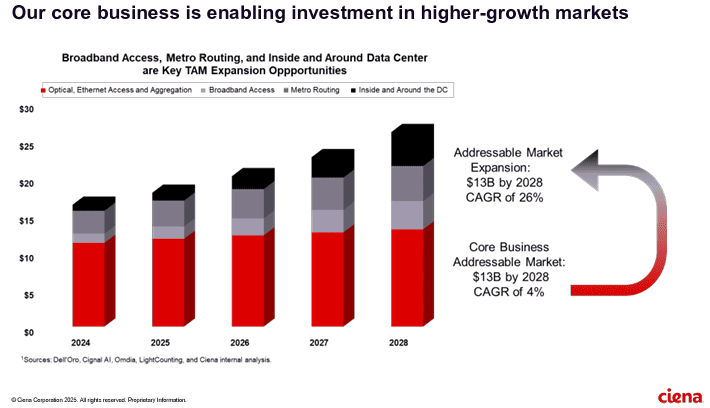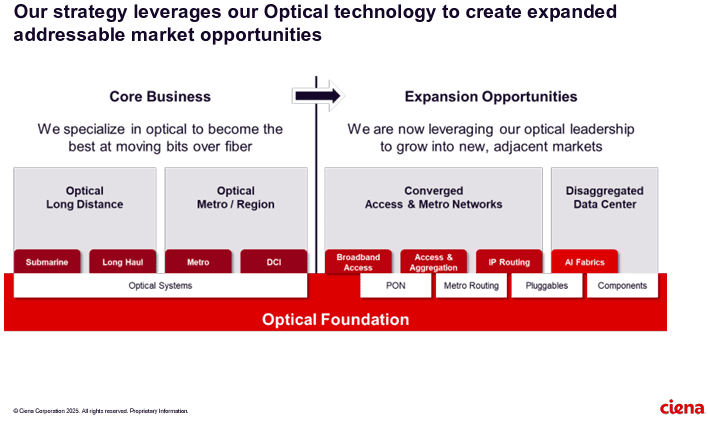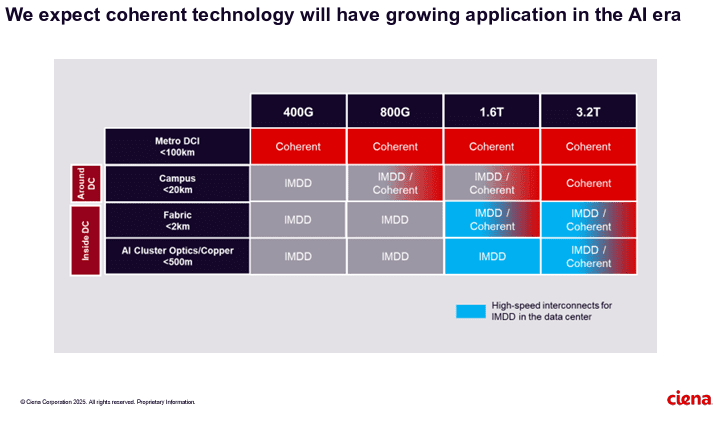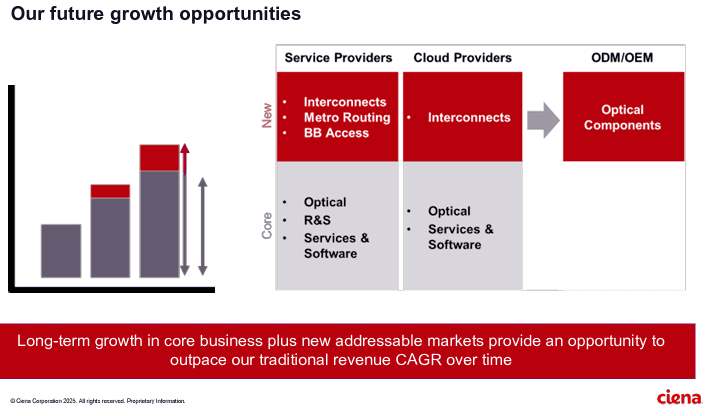Qualcomm to acquire Alphawave Semi for $2.4 billion; says its high-speed wired tech will accelerate AI data center expansion
Qualcomm Inc. has agreed to buy London-listed semiconductor company Alphawave IP Group Plc (“Alphawave Semi”) for about $2.4 billion in cash to expand its technology for artificial intelligence (AI) in data centers. The deal is expected to close in the first quarter of 2026, subject to regulatory and shareholder approval.
Alphawave Semi is claimed to be a global leader in high-speed wired connectivity and compute technologies delivering IP, custom silicon, connectivity products and chiplets. It’s products ‘form a part of the core infrastructure enabling next generation services in a wide array of high growth applications’ such as data centers, AI, data networking and data storage, according to the press release.
Regarding connectivity, Alphawave Semi develops industry leading PAM4 and Coherent DSP products in the most advanced technologies for all forms of data center connectivity.
Alphawave (which held an initial public offering in 2021 at 410 pence per share) has consistently traded below that level. The company had struggled with a reliance on large customers and navigating geopolitical tensions between the US and China, where Alphawave decided to cut back its business last year.
Still, the company’s technology has been gaining traction and had reported a surge in orders in the fourth quarter. Chief Executive Officer Tony Pialis said in a statement at the time that orders from North American AI customers were driving the business.
Qualcomm Chief Executive Officer Cristiano Amon is looking to reduce the company’s reliance on the smartphone market, where growth has slowed, and push into new areas. Alphawave makes high-speed semiconductor and connectivity technology that can be used for data centers and AI applications, two growth areas in the chip industry that are being driven by demand for products like OpenAI’s ChatGPT.

Image credit: Qualcomm / Alphawave Semi
“Qualcomm’s acquisition of Alphawave Semi represents a significant milestone for us and an opportunity for our business to join forces with a respected industry leader and drive value to our customers,” said Tony Pialis, president and CEO of Alphawave Semi. “By combining our resources and expertise, we will be well-positioned to expand our product offerings, reach a broader customer base, and enhance our technological capabilities. Together, we will unlock new opportunities for growth, drive innovation, and create a leading player in AI compute and connectivity solutions.”
“Under Tony’s leadership Alphawave Semi has developed leadi
ng high-speed wired connectivity and compute technologies that are complementary to our power-efficient CPU and NPU cores,” said Mr. Amon. “Qualcomm’s advanced custom processors are a natural fit for data center workloads. The combined teams share the goal of building advanced technology solutions and enabling next-level connected computing performance across a wide array of high growth areas, including data center infrastructure.”
References:
https://www.qualcomm.com/news/releases/2025/06/qualcomm-to-acquire-alphawave-semi
https://www.telecoms.com/enterprise-telecoms/qualcomm-to-purchase-alphawave-semi
MediaTek overtakes Qualcomm in 5G smartphone chip market
AI infrastructure investments drive demand for Ciena’s products including 800G coherent optics
Artificial Intelligence (AI) infrastructure investments are starting to shift toward networks needed to support the technology, rather than focusing exclusively on computing and power, according to Ciena Chief Executive Gary Smith. The trends helped Ciena swing to a profit and post a 24% jump in sales in the recent quarter.
The company enables high-speed fiber optic connectivity for telecommunications and data centers, helping hyper-scalers such as Amazon and Microsoft support AI initiatives via data center interconnects and intra-data center networking. Currently, the company is ramping up production to meet surging demand fueled by cloud and AI investments.
“There’s no point in investing in these massive amounts of GPUs if we’re going to strand it because we didn’t invest in the network,” Smith said Thursday.
……………………………………………………………………………………………………………………………………………………..
Ciena sees a bright future in 800G coherent optics that can accommodate AI traffic. Smith said a global cloud provider has selected Ciena’s coherent 800-gig pluggable modules and Reconfigurable Line System (RLS) photonics for investing in geographically distributed, regional GPU clusters. “With our coherent optical technology ideally suited for this type of connectivity, we expect to see more of these opportunities emerge as cloud providers evolve their data center network architectures to support their AI strategies,” he added.
It’s still early innings for 800G adoption, but demand is climbing due to AI and cloud connectivity. Vertical Systems Group expects to see “a measurable increase” in 800G installations this year. Dell’Oro optical networking analyst Jimmy Yu noted on LinkedIn Ciena’s data center interconnect win is the first he’s heard of that involves connecting GPU clusters across 100+ kilometer spans. “It was a hot topic of discussion for nearly 2 years. It is now going to start,” Yu said.
……………………………………………………………………………………………………………………………………………………
Ciena’s future growth opportunities include network service and cloud service providers as well as ODM/OEM sales of optical components.
References:
https://www.wsj.com/business/earnings/ciena-swings-to-profit-as-ai-investments-drive-demand-0195f30c
https://investor.ciena.com/static-files/d964ccac-74b3-43d9-a73e-ecf67fab6060
https://www.fierce-network.com/broadband/ciena-now-expects-tariff-costs-10m-quarter
HPE cost reduction campaign with more layoffs; 250 AI PoC trials or deployments
Hewlett Packward Enterprise (HPE) is going through yet another restructuring to reduce costs and to capitalize on the AI use cases it’s been developing. HPE’s workforce reduction program announced in March 2025 was to reduce its headcount of around 61,000 by 2,500 and to have another reduction of 500 people by attrition, over a period of 12 to 18 months, eliminating about $350 million in annual costs when it is said and done. The plan is to have this restructuring done by the end of this fiscal year, which comes to a close at the end of October. The headcount at the end of Q2 Fiscal Year 2025 was 59,000, so the restructuring is proceeding apace and this is, by the way, the lowest employee count that HPE’s enterprise business has had since absorbing Compaq in the wake of the Dot Com Bust in 2001.
The company, which sells IT servers, network communications equipment and cloud services, employed about 66,000 people in 2017, not long after it was created by the bi-section of Hewlett-Packard (with the PC- and printer-making part now called HP Inc). By the end of April this year, the number of employees had dropped to 59,000 – “the lowest we have seen as an independent company,” said HPE chief financial officer of Marie Myers, on the company’s Wednesday earnings call (according to this Motley Fool transcript)– after 2,000 job cuts in the last six months. By the end of October, under the latest plans, HPE expects to have shed another 1,050 employees.
Weak profitability of its server and cloud units is why HPE now attaches such importance to intelligent edge. HPE’s networking division today encompasses the Aruba enterprise Wi-Fi business along with more recent acquisitions such as Athonet, an Italian developer of core network software for private 5G. It accounts for only 15% of sales but a huge 41% of earnings, which makes it HPE’s most profitable division by far, with a margin of 24%.
Customer growth is slowing at HPE’s GreenLake cloud services division. Only 1,000 customers added in the quarter, bringing to total to 42,000 worldwide. The annualized run rate for the GreenLake business inched up to $2.2 billion, compared to $2.1 billion in Q1 F2025 and from $1.5 billion a year ago. It is in this area that HPE plans to accelerate it’s AI growth, via Nvidia’s AI/GPU chips.
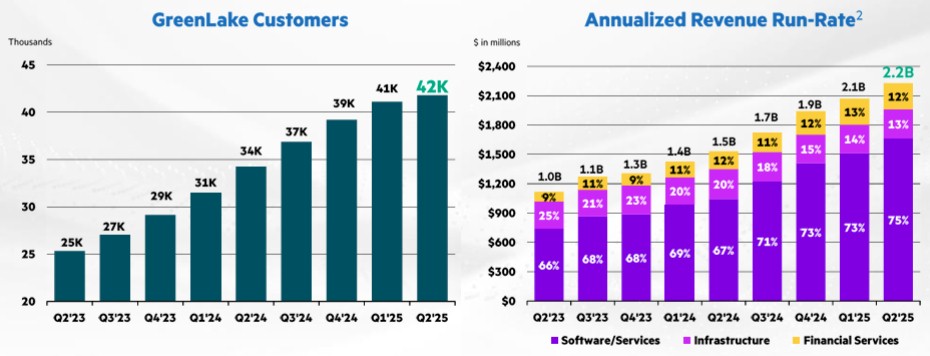
Source: HPE
With respect to the Juniper Networks acquisition, there is a possibility that the $14 billion deal may collapse. A legal battle in court is due to begin on July 9th, but Neri talked on the analyst call about exploring “a number of other options if the Juniper deal doesn’t happen.”
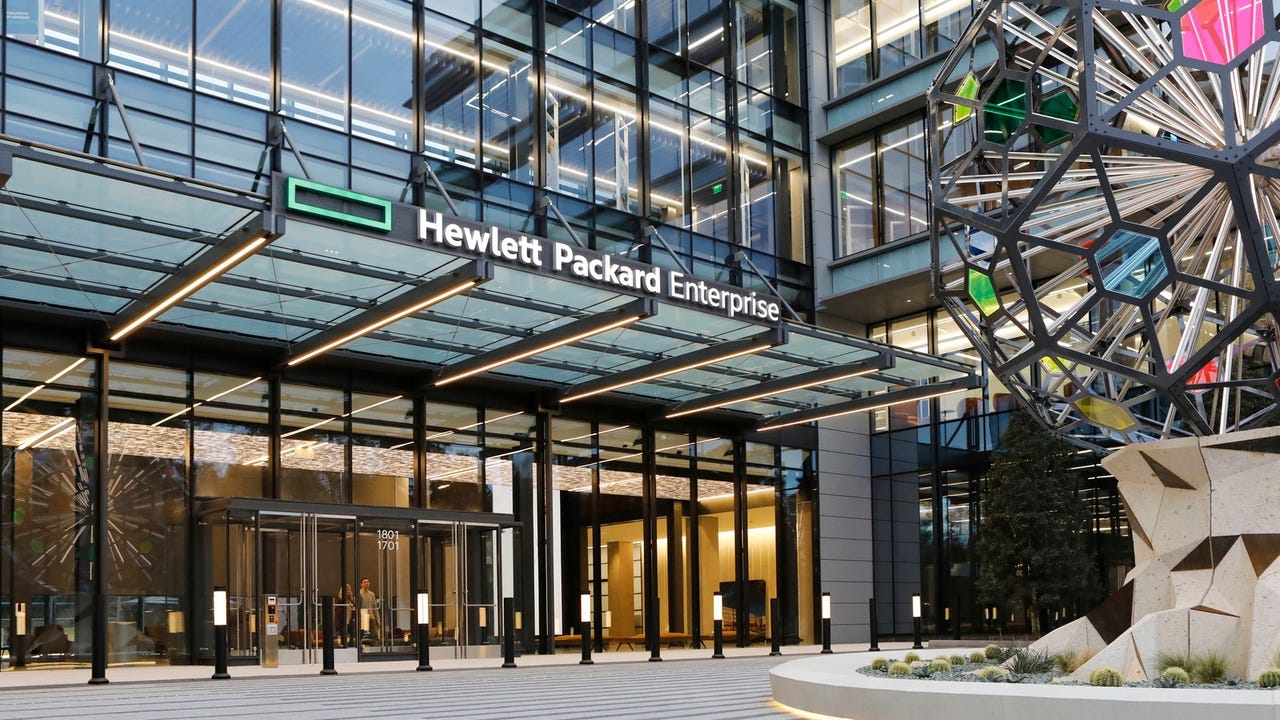
Photo Credit: HPE
Apparently, artificial intelligence (AI) is allowing HPE to eject staff it once needed. It has apparently worked with Deloitte, a management consultancy, to create AI “agents” based on Nvidia’s technology and its own cloud. Let loose in finance, those agents already seem to be taking over some jobs. “This strategic move will transform our executive reporting,” said Myers. “We’re turning data into actionable intelligence, accelerating our reporting cycles by approximately 50% and reducing processing costs by an estimated 25%. Our ambition is clear: a leaner, faster and more competitive organization. Nothing is off limits.”
HPE CEO Anthony Neris AI comments on yesterday’s earnings call:
Ultimately, it comes down to the mix of the business with AI. And that’s why we take a very disciplined approach across the AI ecosystem, if you will. And what I’m really pleased in AI is that this quarter, one-third of our orders came from enterprise, which tend to come with higher margin because there is more software and services attached to that enterprise market. Then you have to pay attention also to working capital. Working capital is very important because in some of these deals, you are deploying a significant amount of capital and there is a time between the capital deployment and the revenue profit recognition. So that’s why, it is a technology transition, there is a business transition, and then there’s a working capital transition. But I’m pleased with the progress we made in Q2.
The fact is that we have more than 250 use cases where we are doing PoCs (Proof of Concepts) or already deploying AI. In fact, more than 40 are already in production. And we see the benefits of that across finance, global operations, marketing, as well as services. So that’s why we believe there is an opportunity to accelerate that improvement, not just by reducing the workforce, but really becoming nimbler and better at everything we do.
- About Hewlett Packard Enterprise (HPE):
HP Enterprise (HPE) is a large US based business and technology services company. HPE was founded on 1 November 2015 as part of splitting of the Hewlett-Packard company. The company has over 240,000 employees and the headquarters are based in Palo Alto, CA (as of 2016).
HPE operates in 60 countries, centered in the metropolitan areas of Dallas-Fort Worth; Detroit; Des Moines and Clarion, Iowa; Salt Lake City; Indianapolis; Winchester, Kentucky; Tulsa, Oklahoma; Boise, Idaho; and Northern Virginia in the United States. Other major locations are as follows: Argentina, Colombia, Costa Rica, India, Brazil, Mexico, the United Kingdom, Australia, Canada, Egypt, Germany, New Zealand, Hungary, Spain, Slovakia, Israel, South Africa, Italy, Malaysia and the Philippines.
HPE has four major operating divisions: Enterprise Group, which works in servers, storage, networking, consulting and support; Services; Software; and Financial Services. In May 2016, HPE announced it would sell its Enterprise Services division to one of its competitors, Computer Sciences Corporation (CSC).
References:
UK’s CityFibre launches 5.5Gbit/s wholesale broadband service- 3 times faster than BT Openreach
CityFibre, the UK’s largest independent full fiber optic platform, has unveiled a new 5.5Gbit/s wholesale broadband internet service based on 10Gbit/s XGS-PON technology that has already been rolled out across 85% of the company’s network. CityFibre claims its new product is more than three times faster than the highest rate available service from its much larger rival, Openreach (the network access arm of BT). and available at a much lower wholesale cost, CityFibre’s 5.5Gb symmetrical product will enable partners to offer a range of Multi-Gig speed tiers to customers, improving margins whilst providing a valuable customer retention tool for the long term.
Highlights:
- CityFibre’s new 5500/5500Mbps service offers >3x faster downloads, >45x faster uploads than BT Openreach’s fastest full fibre service which is 1800/120Mbps and is delivered over its GPON network.
- CityFibre’s upgraded XGS-PON network provides numerous benefits over GPON technology, including network cost savings, reduced power consumption, improved performance, and enhanced efficiency.
- CityFibre’s launch of its new Multi-Gig products enables the UK to keep pace with countries including France, the Netherlands, New Zealand and the United States of America where consumers are already making the most of affordable Multi-Gig services.

Photo Credit: CityFibre
Greg Mesch, CEO of CityFibre, said: “The UK’s full fibre future is here, thanks to CityFibre’s powerful, 10Gb XGS-PON network. Our ISP partners are already connecting customers with speeds over 2Gb and exceeding expectations when it comes to quality and reliability, but our next generation of full fibre will set a new standard for what’s possible.
“CityFibre started out to challenge the incumbents and bring choice and competition to the UK market. This is another huge step-forward, giving ISPs more power and flexibility than ever before and bringing affordable Multi-Gig speeds and an unrivalled experience to millions of UK consumers.”
Even faster multi-gig services will be launched in 2026 the company promises.
CityFibre’s network now passes more than 4.3 million premises, which the company says means it is more than halfway along its journey towards its “rollout milestone” of 8 million premises. Actual service take-up, however, has reached just 518,000, an increase of around 181,000 customers on its previous total. During the year covered by the earnings statement, CityFibre announced a partnership with Sky that will see the UK’s second-largest broadband provider launch services on CityFibre’s network later this year.
References:
https://cityfibre.com/news/cityfibre-unveils-new-5-5gb-wholesale-product-its-fastest-ever
Nokia and CityFibre sign 10 year agreement to build 10Gb/second UK broadband network
Dell’Oro: Broadband access equipment sales to increase in 2025 led by XGS-PON deployments
Frontier Communications offers first network-wide symmetrical 5 Gig fiber internet service
Frontier Communications fiber growth accelerates in Q1 2025
AT&T grows fiber revenue 19%, 261K net fiber adds and 29.5M locations passed by its fiber optic network
Google Fiber planning 20 Gig symmetrical service via Nokia’s 25G-PON system
STELLAR Broadband offers 10 Gigabit Symmetrical Fiber Internet Access in Hudsonville, Michigan
Dell’Oro: RAN revenue growth in 1Q2025; AI RAN is a conundrum
Dell’Oro Group just completed its 1Q-2025 Radio Access Network (RAN) report. Initial findings suggest that after two years of steep declines, market conditions improved in the quarter. Preliminary estimates show that worldwide RAN revenue, excluding services, stabilized year-over-year, resulting in the first growth quarter since 1Q-2023. Author Stefan Pongratz attributes the improved conditions to favorable regional mix and easy comparisons (investments were very low same quarter lasts year), rather than a change to the fundamentals that shape the RAN market.
Pongratz believes the long-term trajectory has not changed. “While it is exciting that RAN came in as expected and the full year outlook remains on track, the message we have communicated for some time now has not changed. The RAN market is still growth-challenged as regional 5G coverage imbalances, slower data traffic growth, and monetization challenges continue to weigh on the broader growth prospects,” he added.
Vendor rankings haven’t changed much in several years, as per this table:
Additional highlights from the 1Q 2025 RAN report:
– Strong growth in North America was enough to offset declines in CALA, China, and MEA.
– The picture is less favorable outside of North America. RAN, excluding North America, recorded a fifth consecutive quarter of declines.
– Revenue rankings did not change in 1Q 2025. The top 5 RAN suppliers (4-Quarter Trailing) based on worldwide revenues are Huawei, Ericsson, Nokia, ZTE, and Samsung.
– The top 5 RAN (4-Quarter Trailing) suppliers based on revenues outside of China are Ericsson, Nokia, Huawei, Samsung, and ZTE.
– The short-term outlook is mostly unchanged, with total RAN expected to remain stable in 2025 and RAN outside of China growing at a modest pace.
Dell’Oro Group’s RAN Quarterly Report offers a complete overview of the RAN industry, with tables covering manufacturers’ and market revenue for multiple RAN segments including 5G NR Sub-7 GHz, 5G NR mmWave, LTE, macro base stations and radios, small cells, Massive MIMO, Open RAN, and vRAN. The report also tracks the RAN market by region and includes a four-quarter outlook. To purchase this report, please contact us by email at [email protected]
………………………………………………………………………………………………………………………………………………………………………………..
Separately, Pongrantz says “there is great skepticism about AI’s ability to reverse the flat revenue trajectory that has defined network operators throughout the 4G and 5G cycles.”
The 3GPP AI/ML activities and roadmap are mostly aligned with the broader efficiency aspects of the AI RAN vision, primarily focused on automation, management data analytics (MDA), SON/MDT, and over-the-air (OTA) related work (CSI, beam management, mobility, and positioning).
Current AI/ML activities align well with the AI-RAN Alliance’s vision to elevate the RAN’s potential with more automation, improved efficiencies, and new monetization opportunities. The AI-RAN Alliance envisions three key development areas: 1) AI and RAN – improving asset utilization by using a common shared infrastructure for both RAN and AI workloads, 2) AI on RAN – enabling AI applications on the RAN, 3) AI for RAN – optimizing and enhancing RAN performance. Or from an operator standpoint, AI offers the potential to boost revenue or reduce capex and opex.
While operators generally don’t consider AI the end destination, they believe more openness, virtualization, and intelligence will play essential roles in the broader RAN automation journey.
Operators are not revising their topline growth or mobile data traffic projections upward as a result of AI growing in and around the RAN. Disappointing 4G/5G returns and the failure to reverse the flattish carrier revenue trajectory is helping to explain the increased focus on what can be controlled — AI RAN is currently all about improving the performance/efficiency and reducing opex.
Since the typical gains demonstrated so far are in the 10% to 30% range for specific features, the AI RAN business case will hinge crucially on the cost and power envelope—the risk appetite for growing capex/opex is limited.
The AI-RAN business case using new hardware is difficult to justify for single-purpose tenancy. However, if the operators can use the resources for both RAN and non-RAN workloads and/or the accelerated computing cost comes down (NVIDIA recently announced ARC-Compact, an AI-RAN solution designed for D-RAN), the TAM could expand. For now, the AI service provider vision, where carriers sell unused capacity at scale, remains somewhat far-fetched, and as a result, multi-purpose tenancy is expected to account for a small share of the broader AI RAN market over the near term.
In short, improving something already done by 10% to 30% is not overly exciting. However, suppose AI embedded in the radio signal processing can realize more significant gains or help unlock new revenue opportunities by improving site utilization and providing telcos with an opportunity to sell unused RAN capacity. In that case, there are reasons to be excited. But since the latter is a lower-likelihood play, the base case expectation is that AI RAN will produce tangible value-add, and the excitement level is moderate — or as the Swedes would say, it is lagom.
…………………………………………………………………………………………………………………………………………………………………………………………………………………………………………….
Editor’s Note:
ITU-R WP 5D is working on aspects related to AI in the Radio Access Network (RAN) as part of its IMT-2030 (6G) recommendations. IMT-2030 is expected to consider an appropriate AI-native new air interface that uses to the extent practicable, and proved demonstrated actionable AI to enhance the performance of radio interface functions such as symbol detection/decoding, channel estimation etc. An appropriate AI-native radio network would enable automated and intelligent networking services such as intelligent data perception, supply of on-demand capability etc. Radio networks that support applicable AI services would be fundamental to the design of IMT technologies to serve various AI applications, and the proposed directions include on-demand uplink/sidelink-centric, deep edge, and distributed machine learning.
In summary:
- ITU-R WP5D recognizes AI as one of the key technology trends for IMT-2030 (6G).
- This includes “native AI,” which encompasses both AI-enabled air interface design and radio network for AI services.
- AI is expected to play a crucial role in enhancing the capabilities and performance of 6G networks.
…………………………………………………………………………………………………………………………………………………………………………………………………………………………………………….
References:
Dell’Oro: Private RAN revenue declines slightly, but still doing relatively better than public RAN and WLAN markets
ITU-R WP 5D reports on: IMT-2030 (“6G”) Minimum Technology Performance Requirements; Evaluation Criteria & Methodology
https://www.itu.int/dms_pubrec/itu-r/rec/m/R-REC-M.2160-0-202311-I!!PDF-E.pdf
McKinsey: AI infrastructure opportunity for telcos? AI developments in the telecom sector
A new report from McKinsey & Company offers a wide range of options for telecom network operators looking to enter the market for AI services. One high-level conclusion is that strategy inertia and decision paralysis might be the most dangerous threats. That’s largely based on telco’s failure to monetize past emerging technologies like smartphones and mobile apps, cloud networking, 5G-SA (the true 5G), etc. For example, global mobile data traffic rose 60% per year from 2010 to 2023, while the global telecom industry’s revenues rose just 1% during that same time period.
“Operators could provide the backbone for today’s AI economy to reignite growth. But success will hinge on effectively navigating complex market dynamics, uncertain demand, and rising competition….Not every path will suit every telco; some may be too risky for certain operators right now. However, the most significant risk may come from inaction, as telcos face the possibility of missing out on their fair share of growth from this latest technological disruption.”
McKinsey predicts that global data center demand could rise as high as 298 gigawatts by 2030, from just 55 gigawatts in 2023. Fiber connections to AI infused data centers could generate up to $50 billion globally in sales to fiber facilities based carriers.
Pathways to growth -Exploring four strategic options:
- Connecting new data centers with fiber
- Enabling high-performance cloud access with intelligent network services
- Turning unused space and power into revenue
- Building a new GPU as a Service business.
“Our research suggests that the addressable GPUaaS [GPU-as-a-service] market addressed by telcos could range from $35 billion to $70 billion by 2030 globally.” Verizon’s AI Connect service (described below), Indosat Ooredoo Hutchinson (IOH), Singtel and Softbank in Asia have launched their own GPUaaS offerings.
……………………………………………………………………………………………………………………………………………………………………………………………………………………………….
Recent AI developments in the telecom sector include:
- The AI-RAN Alliance, which promises to allow wireless network operators to add AI to their radio access networks (RANs) and then sell AI computing capabilities to enterprises and other customers at the network edge. Nvidia is leading this industrial initiative. Telecom operators in the alliance include T-Mobile and SoftBank, as well as Boost Mobile, Globe, Indosat Ooredoo Hutchison, Korea Telecom, LG UPlus, SK Telecom and Turkcell.
- Verizon’s new AI Connect product, which includes Vultr’s GPU-as-a-service (GPUaaS) offering. GPU-as-a-service is a cloud computing model that allows businesses to rent access to powerful graphics processing units (GPUs) for AI and machine learning workloads without having to purchase and maintain that expensive hardware themselves. Verizon also has agreements with Google Cloud and Meta to provide network infrastructure for their AI workloads, demonstrating a focus on supporting the broader AI economy.
- Orange views AI as a critical growth driver. They are developing “AI factories” (data centers optimized for AI workloads) and providing an “AI platform layer” called Live Intelligence to help enterprises build generative AI systems. They also offer a generative AI assistant for contact centers in partnership with Microsoft.
- Lumen Technologies continues to build fiber connections intended to carry AI traffic.
- British Telecom (BT) has launched intelligent network services and is working with partners like Fortinet to integrate AI for enhanced security and network management.
- Telus (Canada) has built its own AI platform called “Fuel iX” to boost employee productivity and generate new revenue. They are also commercializing Fuel iX and building sovereign AI infrastructure.
- Telefónica: Their “Next Best Action AI Brain” uses an in-house Kernel platform to revolutionize customer interactions with precise, contextually relevant recommendations.
- Bharti Airtel (India): Launched India’s first anti-spam network, an AI-powered system that processes billions of calls and messages daily to identify and block spammers.
- e& (formerly Etisalat in UAE): Has launched the “Autonomous Store Experience (EASE),” which uses smart gates, AI-powered cameras, robotics, and smart shelves for a frictionless shopping experience.
- SK Telecom (Korea): Unveiled a strategy to implement an “AI Infrastructure Superhighway” and is actively involved in AI-RAN (AI in Radio Access Networks) development, including their AITRAS solution.
- Vodafone: Sees AI as a transformative force, with initiatives in network optimization, customer experience (e.g., their TOBi chatbot handling over 45 million interactions per month), and even supporting neurodiverse staff.
- Deutsche Telekom: Deploys AI across various facets of its operations
……………………………………………………………………………………………………………………………………………………………………..
A recent report from DCD indicates that new AI models that can reason may require massive, expensive data centers, and such data centers may be out of reach for even the largest telecom operators. Across optical data center interconnects, data centers are already communicating with each other for multi-cluster training runs. “What we see is that, in the largest data centers in the world, there’s actually a data center and another data center and another data center,” he says. “Then the interesting discussion becomes – do I need 100 meters? Do I need 500 meters? Do I need a kilometer interconnect between data centers?”
……………………………………………………………………………………………………………………………………………………………………..
References:
https://www.datacenterdynamics.com/en/analysis/nvidias-networking-vision-for-training-and-inference/
https://opentools.ai/news/inaction-on-ai-a-critical-misstep-for-telecos-says-mckinsey
Bain & Co, McKinsey & Co, AWS suggest how telcos can use and adapt Generative AI
Nvidia AI-RAN survey results; AI inferencing as a reinvention of edge computing?
The case for and against AI-RAN technology using Nvidia or AMD GPUs
Telecom and AI Status in the EU
Major technology companies form AI-Enabled Information and Communication Technology (ICT) Workforce Consortium
AI RAN Alliance selects Alex Choi as Chairman
AI Frenzy Backgrounder; Review of AI Products and Services from Nvidia, Microsoft, Amazon, Google and Meta; Conclusions
AI sparks huge increase in U.S. energy consumption and is straining the power grid; transmission/distribution as a major problem
Deutsche Telekom and Google Cloud partner on “RAN Guardian” AI agent
NEC’s new AI technology for robotics & RAN optimization designed to improve performance
MTN Consulting: Generative AI hype grips telecom industry; telco CAPEX decreases while vendor revenue plummets
Amdocs and NVIDIA to Accelerate Adoption of Generative AI for $1.7 Trillion Telecom Industry
SK Telecom and Deutsche Telekom to Jointly Develop Telco-specific Large Language Models (LLMs)
OpenAI partners with G42 to build giant data center for Stargate UAE project
OpenAI, the maker of ChatGPT, said it was partnering with United Arab Emirates firm G42 and others to build a huge artificial-intelligence data center in Abu Dhabi, UAE. It will be the company’s first large-scale project outside the U.S. OpenAI and G42 said Thursday the data center would have a capacity of 1 gigawatt (1 GW) [1], putting it among the most powerful in the world. OpenAI and G42 didn’t disclose a cost for the huge data center, although similar projects planned in the U.S. run well over $10 billion.
………………………………………………………………………………………………………………………………………………………………………..
Note 1. 1 GW of continuous power is enough to run roughly one million top‑end Nvidia GPUs once cooling and power‑conversion overheads are included. That’s roughly the annual electricity used by a city the size of San Francisco or Washington.
“Think of 1MW as the backbone for a mid‑sized national‑language model serving an entire country,” Mohammed Soliman, director of the strategic technologies and cybersecurity programme at the Washington-based Middle East Institute think tank, told The National.
………………………………………………………………………………………………………………………………………………………………………..
The project, called Stargate UAE, is part of a broader push by the U.A.E. to become one of the world’s biggest funders of AI companies and infrastructure—and a hub for AI jobs. The Stargate project is led by G42, an AI firm controlled by Sheikh Tahnoon bin Zayed al Nahyan, the U.A.E. national-security adviser and brother of the president. As part of the deal, an enhanced version of ChatGPT would be available for free nationwide, OpenAI said.
The first 200-megawatt chunk of the data center is due to be completed by the end of 2026, while the remainder of the project hasn’t been finalized. The buildings’ construction will be funded by G42, and the data center will be operated by OpenAI and tech company Oracle, G42 said. Other partners include global tech investor, AI/GPU chip maker Nvidia and network-equipment company Cisco.
Data centers are grouped into three sizes: small, measuring up to about 1,000 square feet (93 square metres), medium, around 10,000 sqft to 50,000 sqft, and large, which are more than 50,000 sqft, according to Data Centre World. On a monthly basis, they are estimated to consume as much as 36,000kWh, 2,000MW and 10MW, respectively.

UAE has at least 17 data centers, according to data compiled by industry tracker DataCentres.com. AFP
The data-center project is the fruit of months of negotiations between the Gulf petrostate and the Trump administration that culminated in a deal last week to allow the U.A.E. to import up to 500,000 AI chips a year, people familiar with the deal have said.
That accord overturned Biden administration restrictions that limited access to cutting-edge AI chips to only the closest of U.S. allies, given concerns that the technology could fall into the hands of adversaries, particularly China.
To convince the Trump administration it was a reliable partner, the U.A.E. embarked on a multipronged charm offensive. Officials from the country publicly committed to investing more than $1.4 trillion in the U.S., used $2 billion of cryptocurrency from Trump’s World Liberty Financial to invest in a crypto company, and hosted the CEOs of the top U.S. tech companies for chats in a royal palace in Abu Dhabi.
As part of the U.S.-U.A.E agreement, the Gulf state “will fund the build-out of AI infrastructure in the U.S. at least as large and powerful as that in the UAE,” David Sacks, the Trump administration’s AI czar, said earlier this week on social media.
U.A.E. fund MGX is already an investor in Stargate, the planned $100 billion network of U.S. data centers being pushed by OpenAI and SoftBank.
Similar accords with other U.S. tech companies are expected in the future, as U.A.E. leaders seek to find other tenants for their planned 5-gigawatt data-center cluster. The project was revealed last week during Trump’s visit to the region, where local leaders showed the U.S. president a large model of the project.
The U.A.E. is betting U.S. tech giants will want servers running near users in Africa and India, slightly shaving off the time it takes to transmit data there.
Stargate U.A.E. comes amid a busy week for OpenAI. On Wednesday, a developer said it secured $11.6 billion in funding to push ahead with an expansion of a data center planned for OpenAI in Texas. OpenAI also announced it was purchasing former Apple designer Jony Ive’s startup for $6.5 billion.
References:
https://www.wsj.com/tech/open-ai-abu-dhabi-data-center-1c3e384d?mod=ai_lead_pos6
https://www.thenationalnews.com/future/technology/2025/05/24/stargate-uae-ai-g42/
Wedbush: Middle East (Saudi Arabia and UAE) to be next center of AI infrastructure boom
Cisco to join Stargate UAE consortium as a preferred tech partner
Cisco to join Stargate UAE consortium as a preferred tech partner
Cisco Systems Inc. today announced the signing of a Memorandum of Understanding (MoU) to join the Stargate UAE consortium as a preferred technology partner. The strategic MoU, signed by Cisco’s Chair and Chief Executive Officer Chuck Robbins together with other consortium partners, G42, OpenAI, Oracle, NVIDIA and SoftBank Group, envisions the construction of an AI data center in Abu Dhabi with a target capacity of 1 GW, with an initial 200 MW capacity to be delivered in 2026.

Photo Credit: Cisco
As a partner in this initiative, Cisco will provide advanced networking, security and observability solutions to accelerate the deployment of next-generation AI compute clusters.
“With the right infrastructure in place, AI can transform data into insights that empower every organization to innovate faster, tackle complex challenges, and deliver tangible outcomes,” said Chuck Robbins, Cisco Chair and CEO. “Cisco is proud to join this consortium to harness the power of AI and deliver the infrastructure that will enable tomorrow’s breakthroughs.”
Today’s announcement follows Robbins’ recent visit to Bahrain, Saudi Arabia, Qatar, and the UAE where Cisco announced a series of strategic initiatives across all phases of the AI transformation in the region. These new initiatives employ Cisco’s trusted technology across the region’s AI infrastructure buildouts, leveraging the company’s deep expertise in networking and security together with longstanding regional partnerships. By fostering the development of secure, AI-powered digital infrastructure and collaborating with key Cisco partners, the company is delivering world-class, trusted technology to the region.
More information on Cisco’s recent announcements in the Middle East is here.
“AI is the most transformative force of our time,” said Nvidia CEO Jensen Huang in a press release Thursday. “With Stargate UAE, we are building the AI infrastructure to power the country’s bold vision – to empower its people, grow its economy, and shape its future.”
The Stargate project, in collaboration with Emirati firm G42, will span 10 square miles and include a 5-gigawatt capacity. As part of the deal, OpenAI and Oracle are slated to manage a 1-gigawatt compute cluster built by G42. The project will include chips from Nvidia, while Cisco Systems will provide connectivity infrastructure.
The companies said an initial 200-megawatt AI cluster should launch next year.
References:
https://www.prnewswire.com/news-releases/cisco-joins-stargate-uae-initiative-302463388.html
https://www.cnbc.com/2025/05/22/stargate-uae-openai-nvidia-oracle.html
More information on Cisco’s recent announcements in the Middle East is here.
Wedbush: Middle East (Saudi Arabia and UAE) to be next center of AI infrastructure boom
España hit with major telecom blackout after power outage April 28th
Spain has suffered its second major telecom outage in two months. A widespread mobile network outage early Tuesday morning May 20th left millions without phone or internet access. The outage, which affected all major operators including Movistar, Orange, Vodafone, Digimobil and O2, began around 2:00 AM CET and worsened by 5:00 AM, disrupting services in major cities such as Madrid, Barcelona, Seville, Valencia, Bilbao and Malaga. Users suffered a complete loss of signal, inability to make calls, receive texts or use mobile data.
Local news site Corriere della Sera had reported that telecom networks across the country were experiencing issues, with the emergency number 112 not working in several areas of the country, including Andalusia, Navarra, and the Basque Country. The outage affected both consumers and enterprises across Spain and took down the “112” Spanish emergency number across multiple communities. Telefonica said it had re-established communications across the country early this afternoon (more below).
The current outage follows a wide-ranging power disruption that affected millions in Spain, Portugal and parts of France on April 28th. That 10-hour-plus electricity outage led to a loss of cellular coverage and mobile data for users. The power failure resulted in mass outages for telco services, with both communications and infrastructure impacted, causing operators to kickstart emergency backup generators to keep services running.
“I can tell you it was much more painful to be without any connectivity for 7 hours – this is what happened – than to be without any electricity for 11 hours,” Oleg Volpin, president of Telefonica Global stated at the recent FutureNet World show in London.
Services were largely restored by the afternoon as landlines and fixed internet services were also reportedly down. “All service has been re-established except for a case or two where teams are working,” Sergio Sanchez, Telefonica’s operations director, said in a video posted online.
References:
https://www.fierce-network.com/wireless/2nd-major-cellular-disruption-weeks-hits-spain
https://www.earthdata.nasa.gov/news/worldview-image-archive/power-outage-spain
Telefónica and Nokia partner to boost use of 5G SA network APIs
Telefónica launches 5G SA in >700 towns and cities in Spain
Wedbush: Middle East (Saudi Arabia and UAE) to be next center of AI infrastructure boom
The next major area of penetration for the AI revolution appears to be the Middle East, Wedbush analysts say in a research note. Analyst Dan Ives said the rapid expansion of artificial intelligence infrastructure in the Middle East marks a “watershed moment” for U.S. tech companies, driven by major developments in Saudi Arabia and the United Arab Emirates. President Trump was recently there to negotiate a deal to have the U.S. tech sector make data centers, supercomputers, software, and overall infrastructure for a massive AI buildout in Saudi Arabia and the U.A.E in the coming years, the analysts say. Saudi Arabia is now due to get 18,000 Nvidia chips for a massive data center while the U.A.E. has Trump’s support to guild the largest data center outside of the U.S., two factors that should start an era of new growth for the U.S. tech sector and be a game-changer for the industry, the analysts say.
“We believe the market opportunity in Saudi Arabia and UAE alone could over time add another $1 trillion to the broader global AI market in the coming year,” Wedbush said. “No Nvidia chips for China… red carpet rollout for the Kingdom,” the firm wrote, contrasting Middle East expansion with chip export restrictions affecting Beijing. Ives called the momentum in the region “a bullish indicator that further shows the U.S. tech’s lead in this 4th Industrial Revolution.” He said that Nvidia CEO Jensen Huang was “the Godfather of AI” and this author totally agrees. Without Nvidia [1.] AI-GPT chips there would be no AI compute servers in the massive data centers now being built.
Wedbush believes Saudi Arabia, the UAE, and Qatar are now on the “priority list” for U.S. tech, with regional demand for AI chips, software, robotics, and data centers expected to surge over the next decade. ……………………………………………………………………………………………………………………………………………………………………………………………
Note 1. Nvidia should see its trend of strong revenue growth continue, but consensus estimates may not fully account for the recent H20 export restriction, Raymond James’ Srini Pajjuri and Grant Li say in a research note. The analysts expect revenue growth between $4 billion and $5 billion during the past six quarters to continue on strong ramps for its Blackwell chip, but they note that the restrictions on the H20 chips present a roughly $4 billion headwind, leaving them to expect limited sequential growth in 2Q. “That said, we fully expect management to sound bullish on 2H given the strong hyperscale capex trends and recent AI diffusion rule changes,” say the analysts. Nvidia is scheduled to report 1QFY26 results on May 28th.
…………………………………………………………………………………………………………………………………………………………………………………………….
Last week, Saudi Arabia unveiled a series of blockbuster AI partnerships with US chip makers, cloud infrastructure providers, and software developers this week, signaling its ambition to become a global AI hub.

Image Credit: Adam Flaherty / Shutterstock.com
Leveraging its $940 billion Public Investment Fund (PIF) and strategic location, Saudi Arabia is forming partnerships to create sovereign AI infrastructure including advanced data centers and Arabic large language models. Google, Oracle, and Salesforce are deepening AI and cloud commitments in Saudi Arabia that will support Vision 2030, a 15-year program to diversify the country’s economy. Within that, the $100 billion Project Transcendence aims to put the kingdom among the top 15 countries in AI by 2030.
The deals include a $20 billion commitment from Saudi firm DataVolt for AI data centers and energy infrastructure in the US and an $80 billion joint investment by Google, DataVolt, Oracle, Salesforce, AMD, and Uber in technologies across both nations, according to a White House fact sheet.
References:
https://finance.yahoo.com/news/wedbush-ives-sees-ai-boom-123710639.html
https://www.wsj.com/tech/tech-media-telecom-roundup-market-talk-87c22df6
US companies are helping Saudi Arabia to build an AI powerhouse


